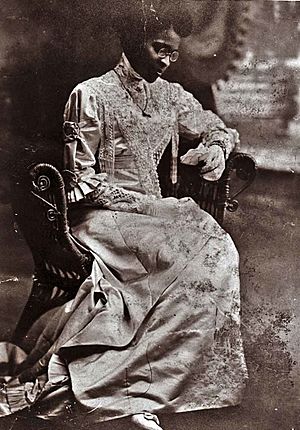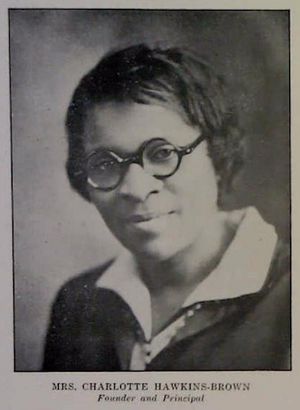Charlotte Hawkins Brown facts for kids
Quick facts for kids
Charlotte Hawkins Brown
|
|
|---|---|

Charlotte Hawkins Brown in wedding dress, 1912
|
|
| Born | June 11, 1883 |
| Died | January 11, 1961 (aged 77) |
| Occupation | Founder of the Palmer Institute |
| Relatives | Maria Hawkins Cole (niece) Natalie Cole (grandniece) Carole Cole (grandniece) |
Charlotte Hawkins Brown (June 11, 1883 – January 11, 1961) was an amazing American teacher, writer, and civil rights leader. She is best known for starting the Palmer Memorial Institute in Sedalia, North Carolina. This school helped many African American students get a great education.
Growing Up
Charlotte Hawkins Brown was born in Henderson, North Carolina, on June 11, 1883. Her grandparents had been slaves. During her childhood, many African Americans were moving north to find new opportunities. Charlotte moved to Cambridge, Massachusetts, when she was very young. There, she grew up and went to school.
Charlotte went to public school in Cambridge with her brother, Mingo. She was a talented student and was chosen to speak at her first graduation. After that, she went to Cambridge English High School. Even though her mother was worried about the cost, Charlotte was determined to continue her education. She decided to attend Salem State Normal School, which trained teachers.
A kind woman named Alice Freeman Palmer, who was on the Massachusetts Board of Education, met Charlotte by chance. Palmer was so impressed by Charlotte's dedication to learning that she paid for all of Charlotte's school expenses.
Building a School
After just one year of college, Charlotte got a job at the Bethany Institute. This was a small school for African American children in a rural area of Sedalia, North Carolina. When Charlotte arrived in 1901, she found that the school had very few supplies or resources.
A year later, the group running the school decided to close it. But Charlotte didn't give up! She decided to create her own school. She started with very little, working from a small blacksmith's cabin. Charlotte worked hard to raise money. Eventually, she bought 200 acres of land and built two new buildings for her school.
The school opened on October 10, 1902. Charlotte named it the Palmer Memorial Institute to honor Alice Freeman Palmer, who had helped her so much. It was a day and boarding school for African American students. Charlotte worked tirelessly to make it a safe and welcoming place. She made sure that the school's board of trustees was made up entirely of African Americans. The Palmer Memorial Institute was one of the only schools in North Carolina that prepared students for college.
By the 1920s, the Palmer Memorial Institute was a very successful school. Students came from all over the country. Many of them went on to become teachers themselves. Charlotte's hard work gained national attention. She often gave speeches at colleges and received special degrees. In 1941, she wrote a book called The Correct Thing To Do--To Say--To Wear. It shared many of her ideas about education and good manners. She continued to lead the school until she retired in 1952.
Besides her work at the Palmer Institute, Charlotte was also active in national efforts to help African Americans. She worked with groups like the Southern Commission for Interracial Cooperation and the Negro Business League. She was the first African American woman to join the national board of the YWCA. She was also an honorary member of the Alpha Kappa Alpha sorority.
Her Lasting Impact
Charlotte Hawkins Brown's important papers are kept at Harvard University.
Today, the restored buildings of the Palmer Memorial Institute are now the Charlotte Hawkins Brown Museum. This museum helps people learn about Charlotte Brown and the Palmer Memorial Institute. It also teaches about the history of African American women, education, and the important contributions African Americans made to education in North Carolina.
Visitors can explore the museum's visitor center, which has exhibits about Charlotte Brown and the school. You can also tour Charlotte's home, called Canary Cottage. It is decorated to look like it did in the 1940s and 1950s, when the school was at its busiest. You can also see several dormitories, the dining hall, and other buildings from the old school campus.
Charlotte's brother, Mingo, was the father of the famous jazz singer Maria Hawkins Cole. Maria married the musician Nat King Cole. Their daughters are the singers Natalie Cole and Carole Cole.


